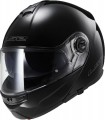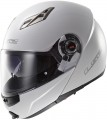—
Quick release visor. The ability to quickly remove the helmet visor, in most cases without the use of special tools. Such an opportunity can be useful, for example, for cleaning from pollution, replacing transparent glass with tinted glass, or vice versa.
—
Anti-fog coating. The presence on the helmet visor of a special coating that prevents fogging from the breath of a motorcyclist. This feature will be useful especially in cold weather (glasses practically do not sweat at high air temperatures). It is especially important for closed helmets (integral and enduro, see "Type"), but can also be found in open ones. Note that such a coating is not a 100% guarantee against fogging, but the likelihood of this phenomenon is greatly reduced.
—
Sun visor. A sunscreen in the form of additional tinted glasses that can be lowered and raised as needed, usually by means of a small lever or button on the side of the helmet. Do not confuse this device with tinted glass (see "Visor" above): a sun visor is provided as an addition to the main visor and covers only the eyes. By lowering and raising such glasses, you can “turn on” and “turn off” additional dimming. At the same time, the main visor is most often made transparent, thanks to which the helmet can be comfortably used at night — just lift the built-in glasses and look through the transparent glass. However,
...the sun visor can also be combined with tinted glass; this option will be appreciated by people with sensitive eyes that do not tolerate sunlight well and require enhanced darkening. The disadvantage of this feature is a noticeable increase in the cost of the helmet.
— UV protection. Availability of UV protection in the glass and/or helmet sun visor (see above). Intense ultraviolet light is harmful to the eyes, it leads to their rapid fatigue, deterioration of vision, and sometimes even eye diseases. Moreover, such radiation can be quite intense not only in sunny, but even in cloudy weather; in addition, the amount of ultraviolet increases in mountainous areas as altitude increases. However with short-term exposure, the described effects are hardly noticeable, but even for trips over short distances, UV protection will be useful. And if you are going to travel "far and long" — this feature is highly desirable. Note that if necessary, UV protection can be provided using separate glasses (motorcycle or conventional), but not all helmets allow the use of such glasses.
— Built-in ventilation. The ventilation system usually has the form of holes in the shell — the air flow entering them "blows" the inside of the helmet. This not only provides comfort (especially in hot weather), but also reduces the amount of moisture accumulating inside: the rider's head sweats less than in a fully closed helmet, and the sweat that is released quickly evaporates and is blown into the ventilation. At the same time, many models provide the ability to completely or partially block the ventilation — for example, in cold or rainy weather.
— Breath cutter. Most often found in helmets of a closed design (integrals, modulars, enduro — see "Type"). In such models, it is a kind of visor that covers the nose and mouth of the motorcyclist — so that the exhaled air is discharged into the lower part of the helmet and the visor does not fog up. Also, sometimes cut-offs are called additional masks that are equipped with open helmets, but this is not entirely true — such masks have a slightly different purpose, they are mainly designed to protect the mouth and nose from dust, small litter, insects, etc.The material from which the shell is made is the outer hard shell of the helmet.
—
Thermoplastic. Material used primarily in inexpensive motorcycle helmets; the most popular option in this category. Thermoplastic (most often it is polycarbonate) is notable for its low cost and has quite sufficient, although not very high, strength characteristics, but it is quite heavy, besides, it “ages” with use due to temperature changes and exposure to ultraviolet radiation; These helmets are recommended to be changed every 5 years.
—
Thermoresin. In terms of basic properties, this material is similar to the plastic described above; at the same time, it is more durable and durable, however, it also costs a little more, which accordingly affects the price of helmets.
—
Fibreglass (fibreglass). In this case, we are not talking about pure glass fibre, but about fibreglass — a composite consisting of fibreglass and a plastic base. Sufficiently strong and reliable, but at the same time quite heavy material, used mainly in mid-level helmets.
—
Carbon. It is also carbon fibre — a composite material that combines carbon fibre and a polymer resin base. This combination allows you to achieve lightness and at the same time extremely high strength, but it is not cheap. Therefore, a carbon fibre shell is usually a si
...gn of a premium helmet.
— Fibreglass / Kevlar. The fibreglass described above, supplemented with a composite based on another fibre — Kevlar. Kevlar is not much inferior to carbon in terms of strength, while it costs less, and such material weighs noticeably less than fibreglass, which significantly affects the mass of the entire helmet. In this case, the materials are usually arranged in layers.
— Carbon / fibreglass. Helmets partly made of carbon, partly made of fibreglass; such a shell usually has a "puff" construction. About the features of each of these materials, see above, and their combination allows you to combine the advantages and partially compensate for the shortcomings. So, such combined helmets are cheaper than pure carbon ones, and in terms of strength they may not be inferior to them. However fibreglass is a heavy material, which accordingly affects the weight; however, such helmets still turn out to be quite light.
— Carbon / Kevlar. Helmets that combine carbon and Kevlar in construction — usually in the form of layers that make up the shell. Both of these materials are detailed above, and the combination is remarkable for its high strength and lower cost than pure carbon. At the same time, these helmets are still expensive, and weigh a little more than carbon ones.
